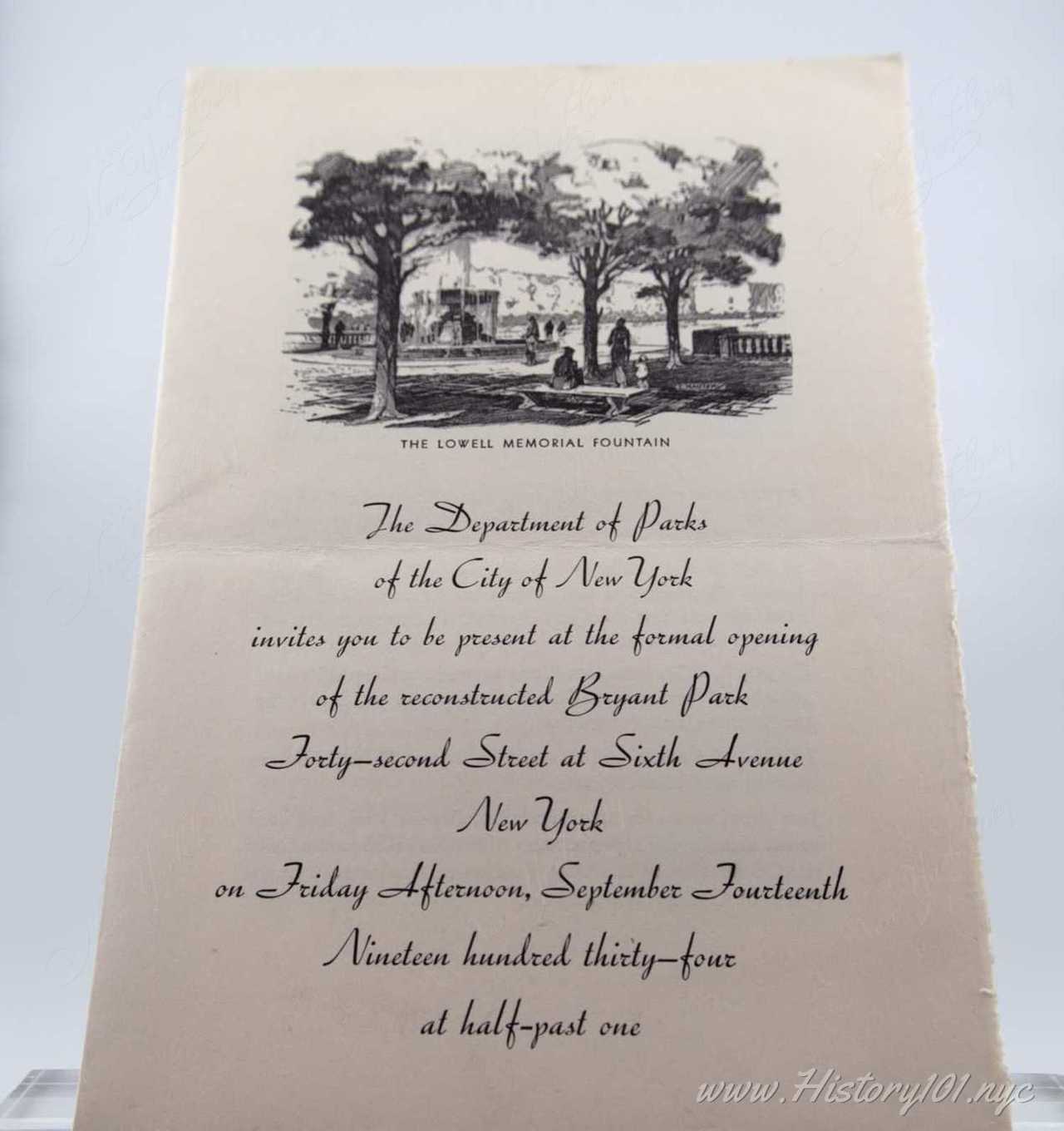
History101.NYC Acquires Original Invitations to 1934 Bryant Park Reopening

History101.NYC Secures Rare 1934 Bryant Park Invitations for Reopening Event
History101.NYC proudly announces the acquisition of original invitations to the 1934 reopening of Bryant Park, a pivotal event in New York City’s urban history. These rare artifacts offer a tangible link to a time when the city embraced transformative changes to revitalize public spaces and uplift community spirit. By preserving these documents, History101.NYC furthers its mission to deepen public understanding of the city’s rich history and to inspire future generations.
The Significance of the 1934 Reopening
On September 14, 1934, the reopening of Bryant Park marked a significant milestone in New York City’s commitment to urban renewal and beautification during the challenging times of the Great Depression. The original invitations are more than memorabilia; they are portals to a transformative era in the city’s history. History101.NYC invites everyone to explore these pieces, fostering appreciation for the narratives that have shaped our metropolis and reminding us of its enduring spirit.
Revitalization Supported by the Architects’ Emergency Committee
Bryant Park, an iconic urban oasis in New York City, underwent a transformative renovation that redefined its landscape. Led by Parks Commissioner Robert Moses, the redesign incorporated the classical vision of Queens-based architect Lusby Simpson, who won a design contest sponsored by the Architects’ Emergency Committee.
The renovation introduced several key features: - A central lawn - Formal pathways - Stone balustrades, echoing the elegance of Paris’ Luxembourg Gardens - Allées of London Plane trees - An oval plaza at the west end featuring the Josephine Shaw Lowell Memorial Fountain
Consulting architect Aymar Embury II and landscape architect Gilmore D. Clarke were instrumental in realizing this vision.
Legacy and Preservation
As part of the New Deal initiatives during the 1930s, the Bryant Park renovation aimed to uplift urban spirits amid economic hardship. The redesigned park was widely acclaimed, becoming a cherished retreat in the heart of Manhattan. Features added during this period, such as the formal pathways and lush tree-lined allées, remain largely intact, preserving its historical layout. On September 14, 1934, Bryant Park officially reopened, marking a significant milestone in New York City’s dedication to rejuvenating public spaces. This careful preservation allows the park to continue serving as a vital community hub and a testament to the era’s commitment to urban renewal.
Bryant Park: A Central New York City Landmark - An Educational Overview
1686 - Established as Public Property
Colonial Designation: Governor Thomas Dongan designates the area that is now Bryant Park as public property, laying the groundwork for its future as a communal space.
1776 - Revolutionary War Significance
Strategic Crossing: General George Washington’s troops are believed to have crossed the area during their retreat following the Battle of Long Island, highlighting its strategic importance.
1823 - Potter’s Field
Public Burial Ground: The site becomes a potter’s field, serving as a public burial ground until 1840, reflecting the city’s growth and changing needs.
1847 - Reservoir Square
Urban Development: Renamed Reservoir Square after the construction of the Croton Distributing Reservoir adjacent to the park, marking a key development in New York City’s water supply system.
1853 - Crystal Palace Exhibition
World’s Fair Venue: Hosts the Exhibition of the Industry of All Nations, showcasing technological advancements in the iconic Crystal Palace, attracting visitors worldwide.
1858 - Crystal Palace Fire
Destruction of Landmark: The Crystal Palace burns down, a significant event that changes the landscape of the park area.
1884 - Renamed Bryant Park
Honoring a Visionary: The park is renamed in honor of William Cullen Bryant, a notable poet, journalist, and editor who advocated for Central Park and green spaces in the city.
1899-1911 - New York Public Library Construction
Cultural Hub Development: The Croton Reservoir is demolished to make way for the New York Public Library’s Main Branch, enhancing the area’s cultural significance.
1934 - Major Redesign and Reopening
Moses and Simpson’s Vision: Under Parks Commissioner Robert Moses and architect Lusby Simpson, the park undergoes a transformative redesign, reopening on September 14, 1934, with classical elements inspired by European gardens.
1969 - Scenic Landmark Designation
Preservation Efforts: Bryant Park is designated a Scenic Landmark by the Landmarks Preservation Commission, recognizing its historical and aesthetic value.
1988-1992 - Restoration and Renewal
Revitalization Project: The Bryant Park Restoration Corporation leads a significant renovation to address safety concerns, culminating in a grand reopening in 1992 that revitalizes the park as a vibrant urban space.
As of the mid-2020s - Present Day
Urban Oasis: Bryant Park remains a cherished urban oasis in Midtown Manhattan, hosting diverse events like New York Fashion Week and outdoor movies. This green space offers a serene escape and vibrant cultural experiences year-round.
Preserving New York’s Heritage: History101.NYC’s Cherished Collections
As History101.NYC continues to expand its collection of artifacts from New York City’s storied past, the original 1934 invitation to the reopening of Bryant Park remains a cherished item that embodies the city’s resilience and transformative spirit. By preserving and showcasing such significant pieces, History101.NYC reaffirms its commitment to deepening public understanding of the city’s rich heritage and inspiring future generations to appreciate the narratives that have shaped modern New York into a vibrant hub of cultural and social interaction.
Bryant Park has not just been a witness to history; it has been a stage where history is made. The 1934 invitations are not just paper—they are portals to an era of transformation and resilience in New York City.















